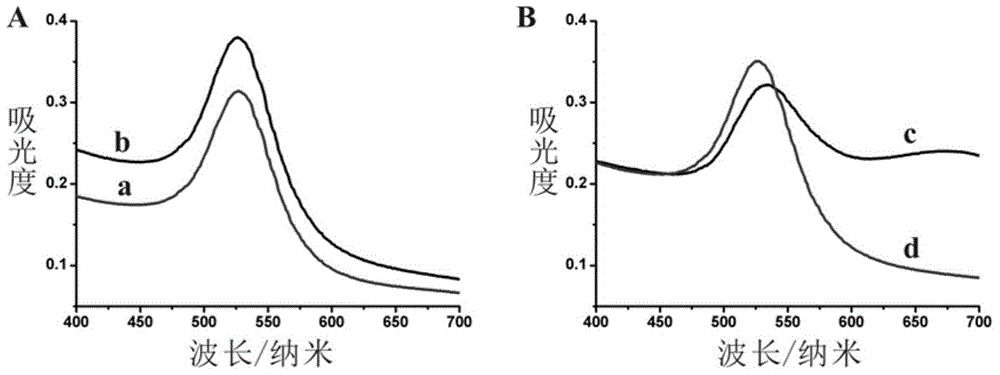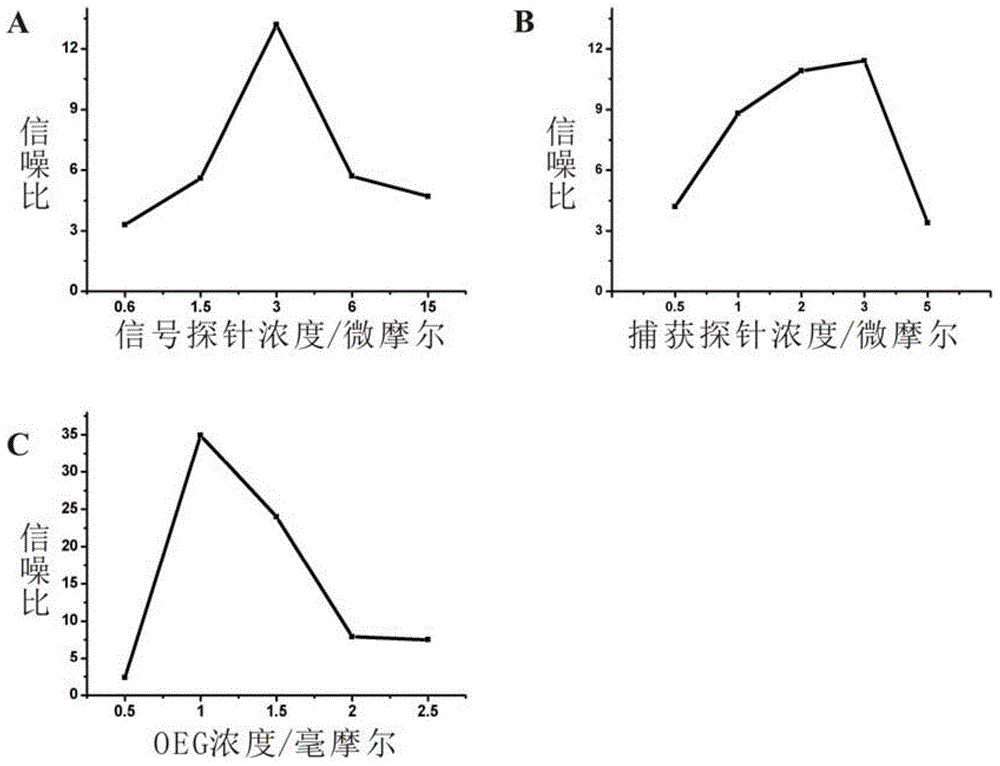Method for detecting carcinoembryonic antigen by nano-probe-induced enzyme polymerization amplification electrochemical aptamer sensor
A carcinoembryonic antigen and nucleic acid aptamer technology, applied in the field of electrochemical biosensor research, can solve the problems of high cost, increase cost, increase the complexity of the reaction system, etc., and achieve strong applicability, high sensitivity, easy simplification and miniaturization. the effect of
- Summary
- Abstract
- Description
- Claims
- Application Information
AI Technical Summary
Problems solved by technology
Method used
Image
Examples
Embodiment 1
[0037] Embodiment 1: the preparation of nanoprobe
[0038] The method for detecting carcinoembryonic antigen by using the nanoprobe-induced enzyme polymerization amplification electrochemical nucleic acid aptamer sensor of the present invention first needs to prepare the nanoprobe. The nanoprobe preparation steps are as follows: centrifuge and concentrate 1000 mL of gold nanoparticle solution to 300 μL, and its final concentration is about 1 nmol / L; slowly add different volumes of 5′ terminal thiol-labeled carcinoembryonic antigen nucleic acid at a concentration of 100 μmol / L. Body signal probe solution; shake and react at 350rpm for 16 hours, add an equal volume of 0.02mol / L PBS (PH=7, 0.2mol / L NaCl), and age for 40 hours; centrifuge at 10000rpm for 15 minutes, add 0.01mol / L PBS (PH=7, 0.1mol / L NaCl), centrifuged at 10000rpm for 15 minutes, and resuspended in PBS (0.01M, 0.25M NaCl) solution containing 1wt% Tween to prepare a nanoprobe solution. Ultraviolet detection was ca...
Embodiment 2
[0039] Example 2: The effect of the signal probe concentration of the 5'-end sulfhydryl-labeled carcinoembryonic antigen nucleic acid aptamer on the detection results of electrochemical signals.
[0040] Using the nanoprobe-induced enzyme polymerization amplification electrochemical nucleic acid aptamer sensor detection method for carcinoembryonic antigen of the present invention, using the carcinoembryonic antigen solution as the target, building a nanoprobe-induced enzyme polymerization amplification electrochemical nucleic acid aptamer sensor system , all the operation steps are as above, wherein the concentration of the assembled 3'-end sulfhydryl-labeled carcinoembryonic antigen nucleic acid aptamer capture probe is 3 μmol / L, the concentration of blocking solution OEG is 1 mmol / L, and the concentration of carcinoembryonic antigen is 1 μg / mL , the nanoprobe adopts the nanoprobe preparation step described in Example 1, wherein the final concentration of the added 5' end sulf...
Embodiment 3
[0041] Example 3: The influence of the assembly density of the 3'-end sulfhydryl-labeled carcinoembryonic antigen nucleic acid aptamer capture probe on the detection results of electrochemical signals.
[0042] The method for detecting carcinoembryonic antigen by using nanoprobe-induced enzyme polymerization and amplifying electrochemical nucleic acid aptamer sensor of the present invention takes carcinoembryonic antigen solution as the target object, and all the operation steps are as described in Example 2, wherein the concentration of the blocking solution OEG It is 1mmol / L, and the concentration of carcinoembryonic antigen is 1 μ g / mL, and the nanoprobe adopts the nanoprobe preparation step described in embodiment 1, wherein the added 5' end sulfhydryl label carcinoembryonic antigen nucleic acid aptamer signal probe The final concentration was 3 μmol / L, and the concentration of the assembled 3'-end sulfhydryl-labeled carcinoembryonic antigen nucleic acid aptamer capture pro...
PUM
 Login to View More
Login to View More Abstract
Description
Claims
Application Information
 Login to View More
Login to View More - R&D
- Intellectual Property
- Life Sciences
- Materials
- Tech Scout
- Unparalleled Data Quality
- Higher Quality Content
- 60% Fewer Hallucinations
Browse by: Latest US Patents, China's latest patents, Technical Efficacy Thesaurus, Application Domain, Technology Topic, Popular Technical Reports.
© 2025 PatSnap. All rights reserved.Legal|Privacy policy|Modern Slavery Act Transparency Statement|Sitemap|About US| Contact US: help@patsnap.com



